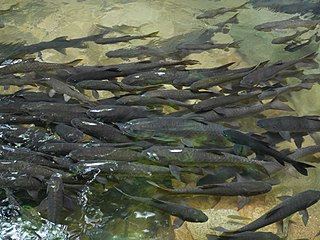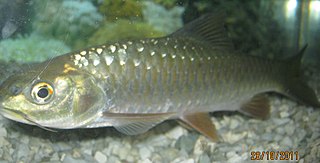
Tor is a genus of freshwater ray-finned fishes belonging to the family Cyprinidae, the family which includes the carps, barbs and related fishes. The fishes in this genus, and some related genera, are commonly known as mahseers. These fishes are found in Asia.

Mahseer is the common name used for the genera Tor, Neolissochilus, Naziritor and Parator in the family Cyprinidae (carps). The name is, however, more often restricted to members of the genus Tor. The range of these fish is from Vietnam in the east and China in the north, through Laos, Cambodia, Thailand, Malaysia, Brunei and Indonesia, and across southern Asia including the countries of India, Nepal, Bhutan and Bangladesh within the Indian Peninsula, plus Sri Lanka, Pakistan and Afghanistan. They are commercially important game fish, as well as highly esteemed food fish. Mahseer fetch high market price, and are potential candidate species for aquaculture. Several of the larger species have suffered severe declines, and are now considered threatened due to pollution, habitat loss, overfishing and increasing concern about the impacts of unregulated release of artificially bred stock of a very limited number of species.
Neolissochilus thienemanni, the ihan, is a species of ray-finned fish in the family Cyprinidae. It is found only in Lake Toba on the island of Sumatra, Indonesia.

Neolissochilus is a genus of fish in the family Cyprinidae native to freshwater habitats in Asia that are often grouped with the mahseers. The largest reach up to 1.2 m (3.9 ft) in length, but most species are much smaller.

Ostorhinchus compressus, commonly called the ochre-striped cardinalfish, blue-eyed cardinalfish or split banded cardinalfish, is a marine cardinalfish from the Indo-West Pacific from the family Apogonidae. It occasionally makes its way into the aquarium trade. It grows to a size of 12 cm in length.
Myroconger is the only genus of eels, the thin eels, in the family Myrocongridae. Very little is known about the group.

Neolissochilus wynaadensis, the Wayanad mahseer, is a species of cyprinid fish. It is endemic to the Wyanad Plateau and its surroundings in the southern Western Ghats, India. It occurs in fast-flowing rivers and streams with rock substrates. This species can reach a length of 50 centimetres (20 in) TL. It is of minor importance to local commercial fisheries.

Neolissochilus soroides, commonly called the soro brook carp is a species of freshwater ray-finned fish belonging to the family Cyprinidae, the family which includes the carps, barbs and related fishes. This species ios found in Thaikand, Malaysia and Sumatra.
Neolissochilus acutirostris is a species of cyprinid in the genus Neolissochilus. This species has a maximum published standard length of 22.6 centimetres (8.9 in). This species is endemic to India where it occurs in the Cauvery River drainage in Karnataka.
Neolissochilus benasi is a species of freshwater ray-finned fish belonging to the family Cyprinidae, the family which includes the carps, barbs and related fishes. This species is found in mountain streams and rivers in the bason of the Trà Khúc River in Quảng Ngãi province in Viet Nam and the Red River basin in Yunnan and northern Viet Nam. This species has a maximum published standard length of 17.4 cm (6.9 in)>
Neolissochilus blanci is a species of freshwater ray-finned fish belonging to the family Cyprinidae, the family which includes the carps, barbs and related fishes. This species is found in the Mekong, Chao Phraya and Mae Klong rivers in Thialnd, Laos, Cambodia and Viet Nam. It may also be found in Myanmar and southern China.
Neolissochilus blythii is a species of freshwater ray-finned fish belonging to the family Cyprinidae, the family which includes the carps, barbs and related fishes. This species is found in the Tenasserim Hills in southern Myanamar.
Neolissochilus dukai is a species of freshwater ray-finned fish belonging to the family Cyprinidae, the family which includes the carps, barbs and related fishes. This species has been recorded from the Ramganga in Uttar Pradesh and the Teesta River near Darjeeling.
Neolissochilus hendersoni is a species of cyprinid in the genus Neolissochilus. It lives in the Malay Peninsula and Thailand.
Neolissochilus heterostomus is a species of freshwater ray-finned fish belonging to the family Cyprinidae, the family which includes the carps, barbs and related fishes. This species is found in the Longchuanjiang and Dayingjiang rivers in the upper Irrawaddy in Yunnan. This species has a maximum published standard length of 23.2 cm (9.1 in).

Neolissochilus hexagonolepis, the copper mahseer, chocolate mahseer or katli, is a species of freshwater ray-finned fish belonging to the family Cyprinidae, the family which includes the carps, barbs and related fishes. This species is found in Nepal, eastern India, Bangladesh, Myanmar, Thailand, Malaysia and Sumatra. It may also be present in China and Viet Nam, also the record sof this species from the easyetn part of its range is uncertain and reports may be misidentifications.

Neolissochilus hexastichus is a species of freshwater ray-finned fish belonging to the family Cyprinidae, the family which includes the carps, barbs and related fishes. It inhabits the Brahmaputra and Barak River drainages in Assam in India, and Nepal and possibly the Salween basin in Myanmar. and is considered "near threatened" on the IUCN Red List.
Neolissochilus longipinnis is a species of freshwater ray-finned fish belonging to the family Cyprinidae, the family which includes the carps, barbs and related fishes. It inhabits Lake Kawar on Sumatra, and is possibly found in the Pangus River drainage of Mount Ungaran on Java, though this population has probably been extirpated. It has a maximum length of 47.5 centimetres (18.7 in).
Neolissochilus stevensonii, commonly known as Stevenson's mahseer is a species within the Cyprinidae family in the genus Neolissochilus. Its only known habitats are in Myanmar.

Hyphessobrycon compressus, the Mayan tetra, is a species of tetra, belonging to the family Characidae. It is the northernmost species in the genus Hyphessobrycon, as well as its type species.






